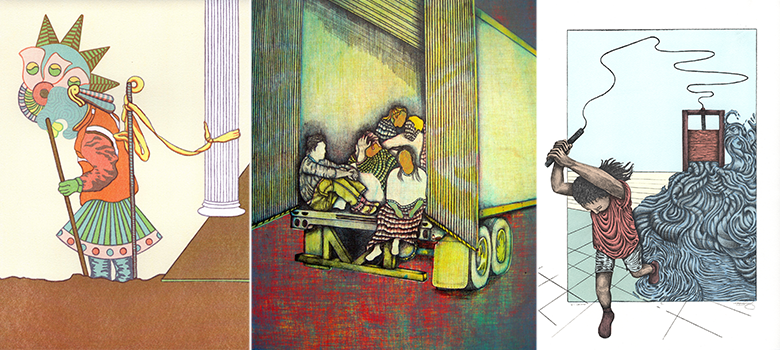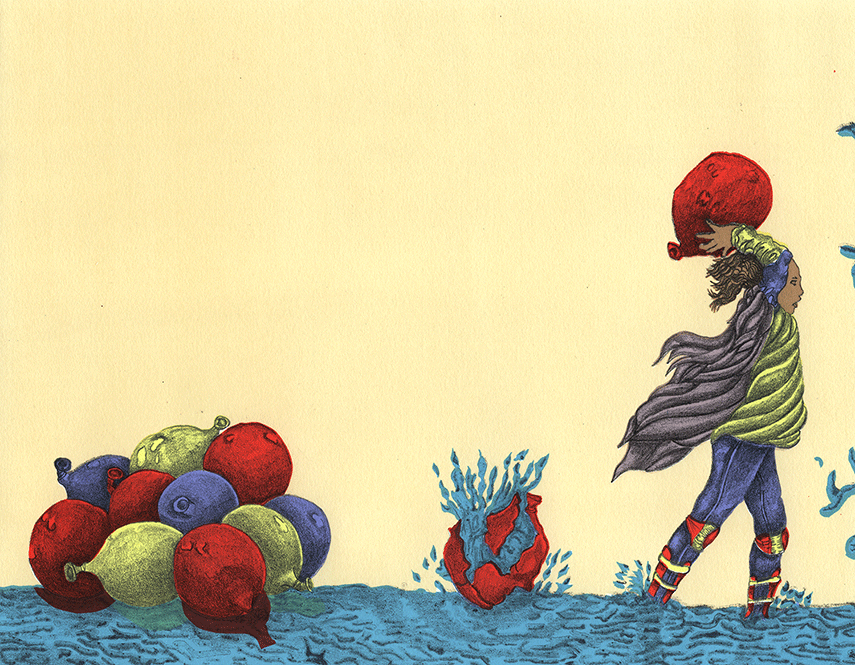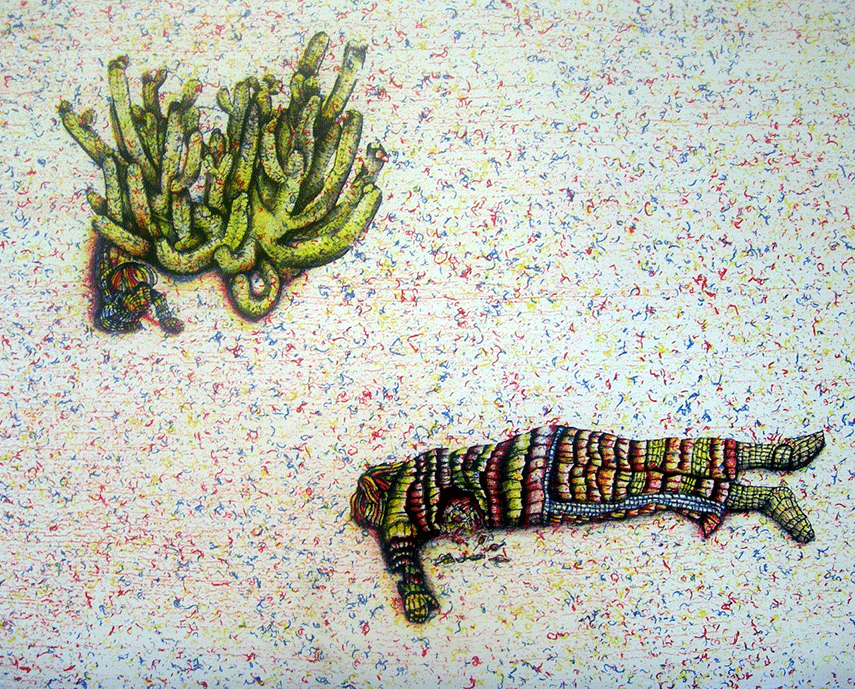
OCTOBER 15, 2021 — Humberto Saenz is telling the stories of migrant communities through printmaking.
He has previously displayed his work in the Museum of Latin American Art in California, across the globe in countries like Portugal and Canada and in local venues.
Now he is using his art to tell the story of those on the border between Mexico and Texas.
UTSA Today spoke with Saenz, who is a professor of art and art history in the UTSA College of Liberal and Fine Arts. He discussed how he got his start in printmaking, his latest work and why he chooses to explore the topics of immigration, identity and children’s rights.

Prints by Humberto Saenz include "Riego" (left), "La Arca" (middle) and "Valero" (right).
You’ve been showcased and recognized all over the world, but how did you get your start in printmaking?
I was introduced to printmaking when I attended Baylor University and I took some classes with my professor Berry Klingman. He inspired me to take printmaking and showed me different ways I could make prints. Later, while I was a graduate student at the University of Dallas, Juergen Strunck, my professor and mentor, helped me develop my work into what it is today.
How did growing up in the Rio Grande Valley and your culture influence you as an artist?
Growing up in the Rio Grande Valley has influenced my artwork, work ethic and my beliefs. The Rio Grande Valley is a place that exists separate from Mexico and the United States. It has its own culture and time, and is unlike any other place. Growing up in a small town in the Rio Grande Valley has shaped my identity and the culture has greatly influenced my prints. The color palette and the depiction of figures within an isolated field alluded to this aspect of growing up there both in an isolated state and within an interweaving of cultures and beliefs.
 Saenz's "Pelea de Globos"
Saenz's "Pelea de Globos"A lot of your work centers around telling the immigrant experience and the issues affecting the migrant communities along the border. How has printmaking allowed you to do that?
Printmaking allows for the dissemination of ideas and the printed image. In my work, I use a variety of different mediums to portray the immigrant experience. I have worked closely in the process of intaglio, serigraphy, woodcut and lithography prints. This has allowed me to make a variety of series of works with a variety of different aesthetics and conceptual focus.
The nature of prints makes them both readily available and allows me to share my work with the public in different venues. The prints are a democratic art form because they are readily available and can be seen by many people.
Why is it important to share the stories of the migrants on the border and the issues they face?
My artwork speaks about issues that have been forgotten or ignored by the government. It is my aim through my artwork to bring to light issues of segregation, objectification and oppression. By making my artwork and exhibiting in venues both nationally and internationally, it will make it evident that these issues are happening and cannot be ignored. Through this, I give immigrant communities a voice which reflects their experience.
My new series of artwork focus on the separation of children and families on the Mexico-Texas border. Particularly I am interested in how the children are affected by this fragmentation. In the artwork, children are engaged in a playful war between their culture, heritage and the laws that bound them to their fate. The children play at war with unseen forces which manipulate and monitor their life without their consent.
Tell me about your latest project featured in the UTSA Art Department right now.
“El Oficio” is a series of limited-edition prints that focus on the sacrifice of heritage and culture in the pursuit of a better life. The focus of this artwork involves research on Mexican Codex. Within the artwork, the imagery encompasses the collective themes of wage, class assignment and manual labor in the United States of America…. The artwork acknowledges the necessity of the American dream with its true nature through the subjugation and exploitation of the working class.
 Saenz's "Crusando la Linea"
Saenz's "Crusando la Linea"What was the inspiration behind it?
The inspiration behind my work is my interest in portraying the immigrant laborers who work tirelessly to achieve the American dream. It is my aim to portray the struggle that different families must endure for a better life.
In these pieces and many of your others, the figures are performing different tasks such as mopping or picking up trash. Why did you choose to showcase them like this?
The jobs are performed by Aztec gods as they immigrate to the U.S. They are sacrificing their identity and their heritage to participate in the American dream. The workers, therefore, have assimilated into a system that has forsaken and scorned them while they try to retain their identity.
You use a lot of Aztec or Mesoamerican elements. Why do you like incorporating these features? Are there any specific elements that repeatedly show up in your art? What is their significance?
In my work, the figures represent gods from Mexican codices, one of a few original indigenous texts still surviving. The gods who participate in the labor force represent different aspects of Mesoamerican daily life. This ongoing and repeatable process of working in the labor force interests me.
Recently, Google Arts and Culture’s Gráfica América, which showcases artists representing print shops, publishing houses and art collectives, featured your work. What does that mean to you?
To be included in Gráfica América among such talented artists has been an extraordinary experience. The work was originally exhibited at the Museum of Latin American Arts (MOLAA) and has since traveled both nationally and internationally. The featured inclusion of my work in Google Arts and Culture has been surreal. I hope this will bring to the forefront the immigrant experience in the U.S.
What is it like to share your passion for printmaking and to share your skills with the young aspiring artists at UTSA?
Teaching at UTSA has been a great experience. The printmaking students love the process and enjoy learning the intricacies of making a print. They are also very interested in the idea of using printmaking as a democratizing artform. Teaching printmaking to first-generation students like myself has also allowed me to share my experience with the students.
UTSA Today is produced by University Communications and Marketing, the official news source of The University of Texas at San Antonio. Send your feedback to news@utsa.edu. Keep up-to-date on UTSA news by visiting UTSA Today. Connect with UTSA online at Facebook, Twitter, Youtube and Instagram.
Move In To COLFA is strongly recommended for new students in COLFA. It gives you the chance to learn about the Student Success Center, campus resources and meet new friends!
Academic Classroom: Lecture Hall (MH 2.01.10,) McKinney Humanities BldgWe invite you to join us for Birds Up! Downtown, an exciting welcome back event designed to connect students with the different departments at the Downtown Campus. Students will have the opportunity to learn about some of the departments on campus, gain access to different resources, and collect some giveaways!
Bill Miller PlazaCome and celebrate this year's homecoming at the Downtown Campus with food, games, giveaways, music, and more. We look forward to seeing your Roadrunner Spirit!
Bill Miller PlazaThe University of Texas at San Antonio is dedicated to the advancement of knowledge through research and discovery, teaching and learning, community engagement and public service. As an institution of access and excellence, UTSA embraces multicultural traditions and serves as a center for intellectual and creative resources as well as a catalyst for socioeconomic development and the commercialization of intellectual property - for Texas, the nation and the world.
To be a premier public research university, providing access to educational excellence and preparing citizen leaders for the global environment.
We encourage an environment of dialogue and discovery, where integrity, excellence, respect, collaboration and innovation are fostered.